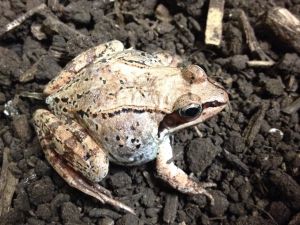
A pretty curious frog
Most frogs spend their winters underwater, at the bottom of a swamp, a river or a lake. But the wood frog has a very special way of getting through the winter.
The wood frog, easily recognized because of its black mask, is reddish, tan or dark brown. It is an average size frog and it can be found in all the provinces and territories of Canada. Observed in the tundra and the grassland, the wood frog prefers humid forests. It can be heard early in the spring, with a series of sharp quacks that almost sounds like a duck.
Since it is the amphibian with the northernmost distribution of all North American species, the wood frog has some special adaptations. The first adaptation is its ability to rapidly change color, from pale to very dark. Contrary to the chameleon that uses the color change for camouflage, the wood frog uses it mainly for temperature regulation. The colder it gets, the darker the frog, in order to absorb more heat.
The second adaptation is for its hibernation. The wood frog is frost tolerant and can resist temperatures below six degrees Celsius and maybe more. Rather than burrowing underground or at the bottom of a waterhole, the wood frog hides under logs or in the layers of dead leaves and then freezes with the lowering temperature. Its breathing, heartbeat and metabolic activities stop. About 60 to 70% of its body water freezes. But how does it survive such conditions? Well the wood frog has cryoprotectors, blood elements that lower the freezing temperature of the body, just like antifreeze. These elements, mainly glucose and urea, are very abundant in the frog’s body and protect the body cells. After spending the winter months completely frozen, the wood frog comes back to life when the ice inside its body thaws as the snow outside does.
Many researchers are trying to comprehend the mechanisms used in this process because it could be used in different medical fields, in the case of organ transplants. While we wait for theses answers, we can still marvel at the amazing adaptation of the little wood frog.
 Author: Stéphanie Bentz, biologist in charge of education
Author: Stéphanie Bentz, biologist in charge of education
